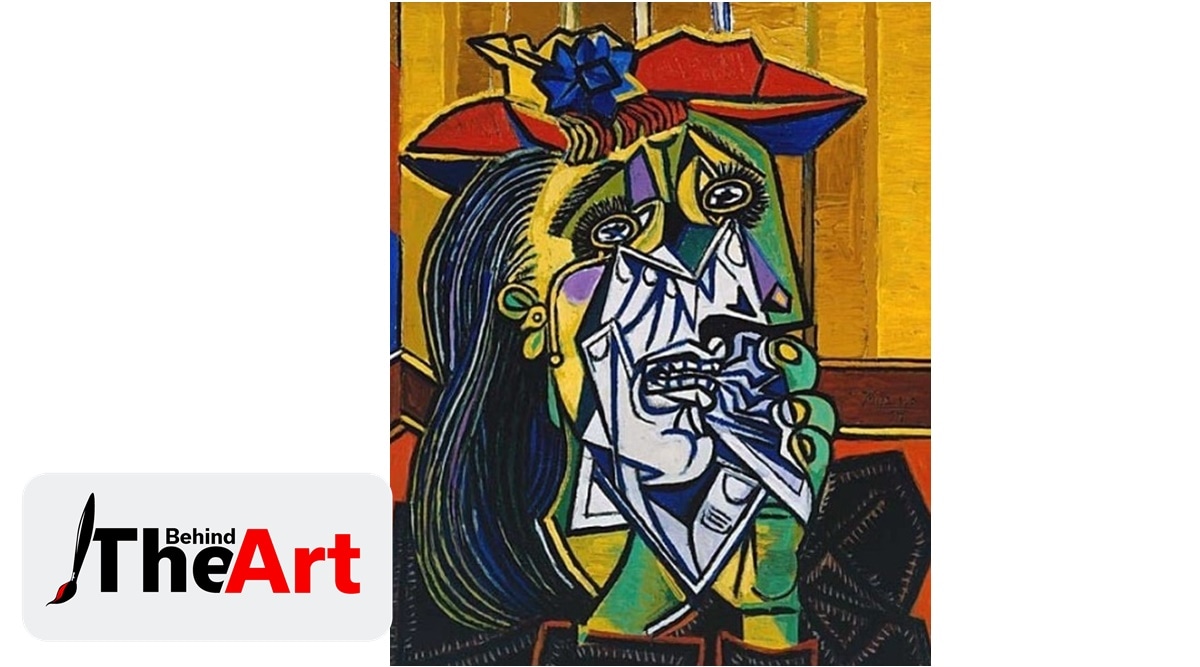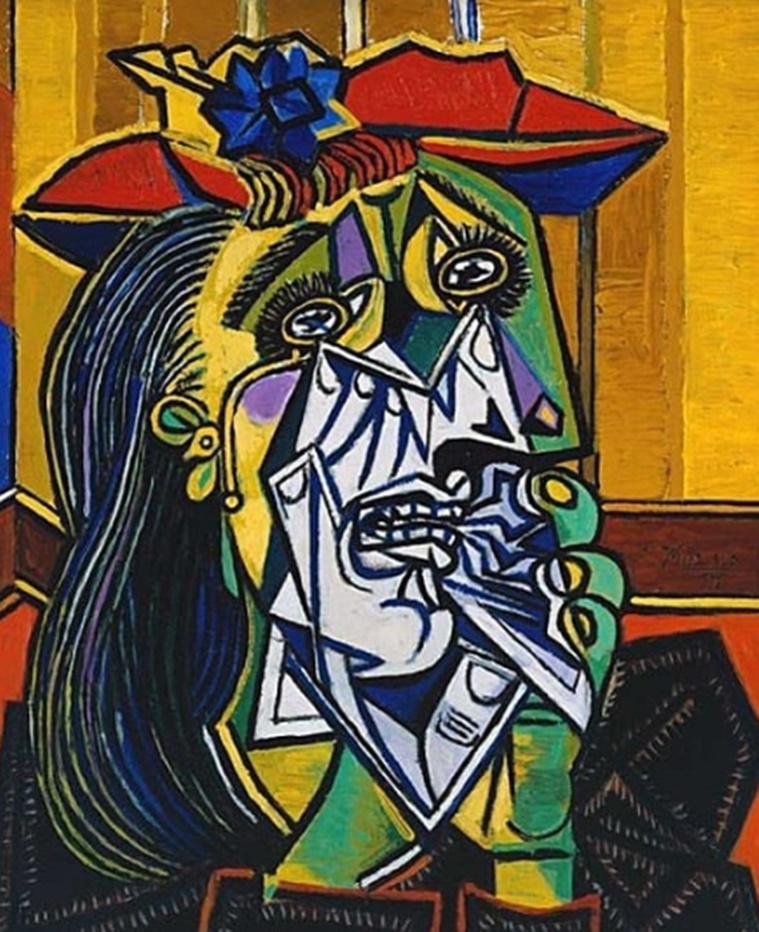 Picasso used bright colours and bold lines to paint a lady by using complex angular shapes and planes. (Photo: Instagram/@captaindadada)
Picasso used bright colours and bold lines to paint a lady by using complex angular shapes and planes. (Photo: Instagram/@captaindadada)As I was surveying the walls of Tate Modern in London a couple of years ago, I was mindlessly trying to learn as much as I could about the endless paintings hanging in the space around me. I distinctly remember the first time I laid my eyes on the Weeping Woman by Pablo Picasso — an oil painting on canvas measuring 61 x 50 cm. I was hypnotised by the powerful image of a grief-stricken woman in the painting. The image of her weeping is so strong, you can feel her pain emanating from the painting. Picasso made this masterpiece to represent the grief and devastation caused by the Spanish Civil War which began in 1936. The painting is based on an image of a woman holding her dead child — taken from Picasso’s anti-war mural Guernica. But the story behind this art is not so simple. Just like every art piece, it has layers of tales hidden behind each brushstroke.
Picasso’s protest against War
During the Spanish Civil War, Adolf Hitler had ordered the German air force to bomb the Basque town on behalf of General Franco. Picasso was asked to produce a mural for the Spanish Pavilion at the Paris International Exhibition when the bombing occurred. He was so shocked by the news that he decided to protest against the bombing of Guernica. He told the Springfield Republican on July 18, 1937: “In the panel on which I am working, which I shall call Guernica, and in all my recent works of art, I clearly express my abhorrence of the military caste which has sunk Spain in an ocean of pain and death”.
Picasso’s obsession with the Weeping Woman
It is known that between June 8 and July 6 1937, Picasso produced a dozen drawings and four oil paintings showing the Weeping Woman. I was fortunate enough to see one of the versions. There are a total of 36 works depicting the Weeping Woman that have been identified so far. But, what got Picasso so obsessed with the image?
While working on Guernica, he started making his first studies of a Weeping Woman. He, however, did not include it in Guernica, because he wanted to first showcase the shock and horror of the destruction caused by war. He wanted to show the Weeping Woman as a symbol of mourning and grief in the aftermath of any war. Historians and art critics believed the Weeping Woman was a metaphor for his private agonies. The truth about the woman in the painting was soon revealed by Picasso himself.
 The face of the woman is related to the figures shown in Guernica but it is very evident that it is the face of Picasso’s lover Dora Maar. (Photo: Instagram/@captaindadada)
The face of the woman is related to the figures shown in Guernica but it is very evident that it is the face of Picasso’s lover Dora Maar. (Photo: Instagram/@captaindadada) The ‘tortured’ Muse Dora Maar
“For me, she’s (Dora Maar) the weeping woman. For years I’ve painted her in tortured forms, not through sadism, and not with pleasure, either; just obeying a vision that forced itself on me. It was the deep reality, not the superficial one… Dora, for me, was always a weeping woman…And it’s important, because women are suffering machines.” — Picasso
This is an infamous quote by Picasso about his mistress Dora Maar, which showcased the reality of how he saw women. It is well known that he used his women as an inspiration for his art. Dora Maar, a French photographer and painter, was yet another muse of the master of Cubism. She became known as the Weeping Woman after people came to know that she was in an abusive relationship with Picasso and he often painted her in tortured forms.
When I first set my eyes on the painting, I could feel the pain in the woman’s eyes. If you look at the tears and her tortured expression, you feel like hugging the woman or sitting down with her and weeping. I, like many viewers in Tate Modern, was oblivious to the harsh truth about Dora Maar’s real-life story.
View this post on Instagram
Picasso’s mastery of composition
Even when one is not oblivious to the background of the story, it is not difficult to appreciate the composition and beauty of the painting. Picasso used bright colours and bold lines to paint a lady by using complex angular shapes and planes. He has not used any colour associated with sorrow, although the sorrow is evident in the eyes of the woman. Her face is related to the figures shown in Guernica, but it is evident that it is the face of Picasso’s lover Dora Maar. The centre of the painting has a mash of hands, mouth, handkerchief, teeth and tears — all seamlessly blending into one. The eyes have been drawn in a child-like manner that helps enhance the grief. Picasso used Cubism in an effective way to portray such strong emotions in the painting. The Weeping Woman is one of the most famous portraits by Picasso, executed in the style of analytical Cubism, but with greater realism than usual.
To emphasise the two-dimensional nature of the work, the artist does not attempt to create ‘depth’ in the painting by the use of linear perspective or any type of modelling/shading like chiaroscuro. The colour scheme remains something of a mystery. Picasso frequently used a monochrome or even a grisaille palette when evoking pain and suffering. The palette used in the Weeping Woman incorporates all the major colours, including red, yellow, blue, as well as orange, green and brown. Was he trying to imbue the woman with strong feelings, or with a vivid sense of life?
At the end of my visit to the Tate Modern, I made sure to buy a postcard of the painting from the gift shop. Its impact was so immense that I wanted to take a piece with me home. Whether one likes to study the Cubism movement or simply wants to enjoy a piece of art, the Weeping Woman will always remain a compelling artwork in the world of modern art.
Next Up in Behind the Art: The Red Vineyard — the only painting known to be sold by Vincent van Gogh in his lifetime.
Subscriber Only Stories
📣 For more lifestyle news, follow us on Instagram | Twitter | Facebook and don’t miss out on the latest updates!
- The Indian Express website has been rated GREEN for its credibility and trustworthiness by Newsguard, a global service that rates news sources for their journalistic standards.

